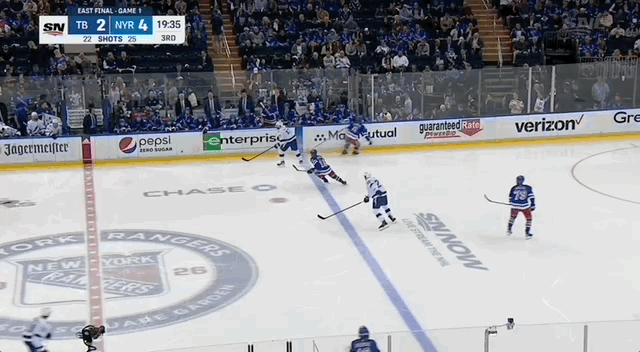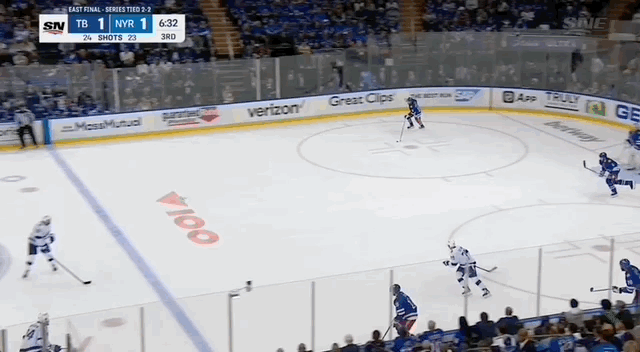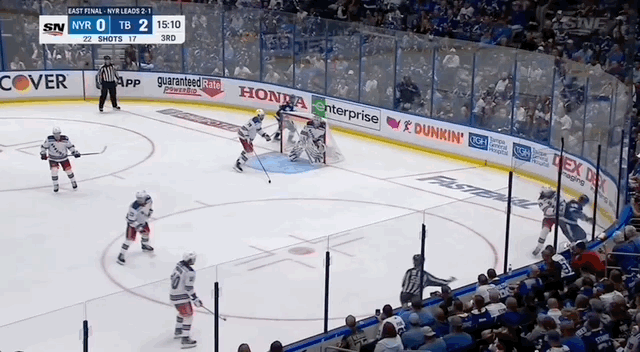
It wasn’t too long ago that the Tampa Bay Lightning were down 2-0 in the Eastern Conference Final.
Was it fatigue setting in after back-to-back Stanley Cup runs? Was it rust after a lengthy break after their Round 2 sweep of the Panthers? Or were the Rangers getting hot at the right time to end their reign as champions?
Well, the narratives have certainly changed just a few days later and so has Tampa Bay’s playing style. Since the series shifted back to Amalie Arena, the Lightning have looked like a much different team than the squad that opened on the road in New York. They’ve taken control of this series with three straight wins, that take them one away from a return to the Stanley Cup Final.
So what’s been the difference? It certainly helps that Andrei Vasilevskiy’s putting up quality starts after rough outings in both Games 1 and 2. But it’s the differences in five-on-five play that’s really flipped this series.
It starts with the little things, like retrieving pucks. Through Games 1 and 2, Tampa Bay did have the advantage here with 190 loose puck retrievals to the Rangers’ 116. But New York had won more puck battles under pressure both in the offensive and defensive zone through that. Between Games 3-5, however, when the Lightning kicked up the intensity, they outright became the more dominant team in this regard.
Throughout the series, the Rangers have held onto the edge in blocked shots, while there’s been swings in who has blocked more passes. The Lightning, however, have stayed stronger in their efforts to hold the blue line and extend zone time.
That’s why it’s no surprise they’ve generated more slot shots throughout the series. The difference is, in Games 1 and 2, New York converted twice on their 12 scoring chances. That swung in the Lightning’s favour over the next three games, with three goals on 14 attempts.
It helped that the Rangers were better at intercepting plays in the two tilts they won, and prevented the Bolts from gaining possession more. But over the next three, their opponent caught up.
What helped in Games 3 and 4 was the Lightning having home ice advantage, which allowed them to put Anthony Cirelli, their best shutdown centre, against Mika Zibanejad as much as possible; that line plus Erik Cernak and Ryan McDonagh really helped stifle one of New York’s biggest threats. And even when play returned to Madison Square Garden in Game 5, the Lightning still managed to get those players out a lot against the Rangers’ top line.
One of the biggest differences in this series, from the games the Rangers took to the Lightning’s wins, is play in transition.
The Lightning may have had more controlled entries in Games 1 and 2, but the Rangers generated more off their plays in transition. Of their 48 five-on-five entries, 70.8 per cent had a successful play to follow, and over 29 percent of entries led to a scoring chance. That helped contribute to New York’s edge in goals, 2-1, off the rush from the slot. The team had a clear advantage in odd-man rushes 12-5 on home ice.
But Tampa Bay regained control by upping their defensive efforts moving forward. They limited what the Rangers were able to do after entering the zone with possession; less than 54 per cent of their entries were followed by a successful play and only 13 scoring chances came of their 78 entries (16.7 percent).
Not only did they take away the Rangers ability to use their transition game to their strengths, but the Lightning improve as well. To start the series, only 45 percent of their controlled entries were followed by a successful play, which improved to almost 60 percent in across their three consecutive wins. Tampa Bay also increased their scoring chance creation off the rush, and led in odd-man rushes 18-9.
That difference in transition really stood out in Game 5, where Tampa Bay put the pressure on so New York had to try a dump-and-chase style that impeded their ability to generate offense.
What also hurt the Rangers in their three losses was a dip in their pass completion rate. While New York has been the better team at connecting passes to the slot throughout the series, the Lightning did their best to limit as much puck movement in the offensive zone which is something the Rangers thrive off of. And on the other end of the ice, they found more success with their own attempts.
Between their shot generation, and pre-shot movement, the Rangers generated 4.44 expected goals at five-on-five through the first two games of this series. They outperformed expectations, beating Vasilevskiy much more than anticipated. But to have a true chance in this series, it was clear they’d have to build on the pressure they were putting on the defending champs.
As much as they can rely on finishing talent, a team has to throw everything they can at one of the best goalies in the league. That means pushing through Tampa Bay’s defensive efforts, and trying to overwhelm offensively which is something they’ve struggled with all year.
That’s come back to bite the Blueshirts these last three games, with a total of 4.39 xG for through three games — which is less than what they mustered through two before this. And the finish hasn’t been there either, even when they get to the quality areas — the Rangers have scored zero goals from the slot, while their opponent’s come up with five.
Tampa Bay was expected to score around five goals in the first pair of games in the Eastern Conference Final due to their shot quality, before even factoring in their shooting talent. But Igor Shesterkin stood tall against their attempts. But over their next three, they came up shots that equated to a collective value of 7.81 expected goals for. They’re still finishing below expected, which makes sense when going up against a spectacular goaltender. But at least they’re challenging him with dangerous chances.
The Lightning may not have been at their best coming into this round, but they’ve flipped this series on its head. Tampa Bay’s taken control with strong play on both ends of the ice, while their opponents been playing a lot more defence than offence.
Now, the defending champs have the advantage, while the Rangers have to find a way once more to keep their season alive.
Data via Sportlogiq











